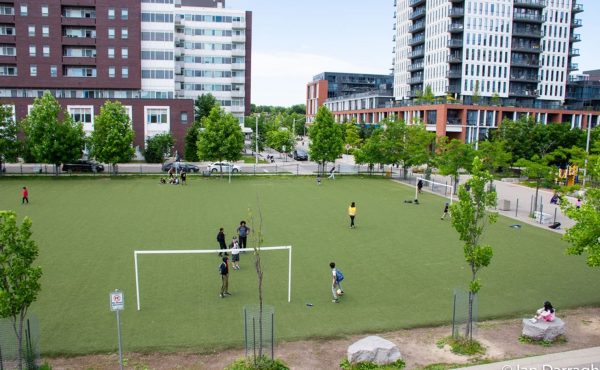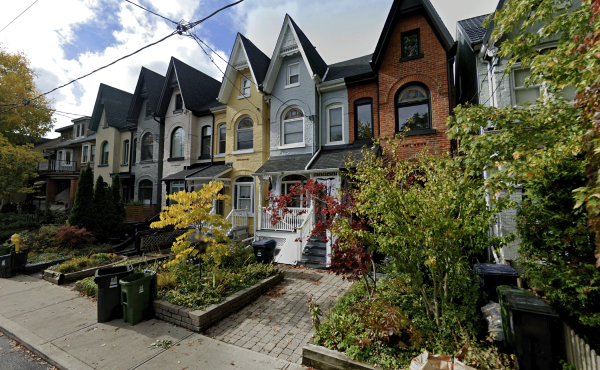Yesterday morning, I got into an argument with a stranger while riding with my wife and kids on the subway. I’d been standing for several stops with my two-year-old in my arms, when an empty seat became available. As I lunged for it, another (young, male) passenger started to sit down. I was, I admit, not polite in asking if we could sit instead of him. I reasoned that our need should be obvious, and our presence unmissable. It turned out I was wrong about that; he really didn’t see us.
But I guess I should be less surprised that I went unnoticed and unregarded; my kids are often the only people their age on transit when we head to and from their daycare in the heart of Toronto. They’re also most definitely in the minority when we walk along Yonge Street at 8:30am, or duck into a restaurant after school instead of scurrying to our east-end home to make dinner. We’re invisible, my brood and I, because we have few comrades, and we’re not remarkable enough in our appearance to cause a stir.
This encounter reminded me of Etobicoke Councillor Doug Holyday’s recent proclamation that King and Spadina is no place to raise children, as well as the many passionate rebuttals to that claim by downtown parents. And it also got me thinking about the Pembina Institute study released shortly after Holyday’s gaffe, and the eloquent analysis of that study by the Star’s Christopher Hume.
With respect to everyone who wrote open letters to Holyday about the joys of being an urban parent, I must concede that Holyday inadvertently made a good point: downtown Toronto is inhospitable in many ways to people with children. Parks are few and far between, accessibility challenges are common in buildings, and the TTC can quickly become a veritable battleground. More advocates challenging these inadequacies would make a huge difference, but that’s unlikely to materialize anytime soon; there are virtually no affordable places in the core in which people like my family and I could live. It’s this point that forms the core of Hume’s column about the Pembina study.
“More families than ever do want to live downtown,” Hume writes, “and most of those who live in suburbs want their neighbourhoods to be more walkable, better connected to transit, more mixed-use, in short, more urban.” The rub, of course, is that downtown Toronto is prohibitively expensive, which is why policies like making three-bedroom units mandatory in new developments (which is what got Holyday all worked up in the first place) are absolutely essential.
The Pembina Institute agrees. “Government needs to do more to make it more attractive for developers to build compact, family-friendly homes,” Cherise Burda, the Ontario policy director at Pembina, said to Hume. “A lot of politicians are still encouraging developers to build sprawl.”
Despite well-intentioned efforts like the proposed family-unit condo rule, we’re veering dangerously close to — as The Arcade Fire song goes — living in a city with no children in it. And while it’s true that there are places downtown where kids probably don’t belong (I’m in the camp who believes that fine dining establishments are the province of adults, and if my wife and I go out to eat somewhere nice, it’s because we’re seeking respite from children for the evening), city-building with families in mind benefits everyone. As Hume points out, parents want things like walkability, green spaces, safe streets, shops and buildings with accessibility features, and easy access to amenities.
On transit, our needs are simple: fare media that make sense; and a place to sit. I dream of a day when I can show a Child Metropass and then find a reserved seat, not one that someone has to give up for me. If we can build parking lots with designated spaces and roads with HOV lanes, surely we can adjust the language and etiquette on the TTC in a similar fashion. This, too, has universal appeal — many transit riders with a need for a seat can’t find and aren’t offered one, and are unwilling or unable to beg for it every time they board. It’s a situation as inhospitable as the lack of affordable downtown housing for families, and is a big reason why so many Toronto parents give up on transit — and, often, urban living itself — altogether. Personally, I’m hoping I’ll never concede defeat on either front, but I would definitely love to stop fighting.




15 comments
Three bedroom condos downtown are very expensive, almost as costly as a single-family dwelling. I’m not convinced this kind of social engineering is well thought out. The culture on the TTC is doable though.
For people with very young children, a key transit need is accessibility, aka: stroller-friendly elevators. I live at Danforth and Coxwell and on several occasions my nearest working elevators at TTC stations were Vic Park and Broadview. I broke the frame on a very expensive stroller because I was committed to getting out in the city with my baby and using the TTC to do it.
The bigger issue — because I can walk to the next station, or drag the gear up and down the stairs if I have to — is one of fairness. My (now slightly older) kids don’t see differently abled people on the TTC and why would they? It’s a nightmare for anyone who finds multiple flights of stairs — and standing whilst in transit, as you note — a challlenge.
Greater accessibility is coming soon to a station near me, but not as fast as the repeated calls for system expansion. I wish the TTC would fix the problems they have before seeking to create others.
Mandating 3-bedroom units in condos doesn’t necessarily ensure an affordable home, and for that reason I am skeptical about Adam Vaughan’s initiative. Units are priced on a per-sf basis, and by the time you get large enough to fit 3 bedrooms into a unit (1,000+sf), including a parking space and outdoor space and monthly condo fees, you’re above the average price for a home in Toronto ($600,000).
Unfortunately you will never be able to fit a family into the $300,000 – $400,000 price range, in a condo, without finding ways to encourage developers to sell those units to families. One could imagine a grant program (for families) or incentive program (for developers) that would make it cost less to build or live in *family* space in a building… like if developers could bring in X families, development fees would cost X(Y) less… meaning any profit they lost could be made up for by a reduction in cost. But getting those kinds of programs to work would probably require so much paperwork and process that it’s probably not feasible for the City. But there have to be other ideas that could work, that go beyond “design big expensive units”, right?
This Pembina study is also worth a review – it shows the cost of living in outlying regions versus downtown, when things like car costs are taken into consideration. They conclude that for each car you can eliminate from a household, you can carry another $200,000 on a 25-year mortgage.
http://www.pembina.org/pub/2362
The transit needs of parents with very small children go beyond just fare structures and seating: the lack of accessibility (aka: stroller-friendly elevators) is a real problem. I live at Danforth and Coxwell and on more than one occasion the closest stations with functioning elevators were at VicPark and Broadview. I eventually broke the frame on a fairly expensive and sturdy stroller by dragging it up and down TTC stairs because I was committed to being out in the city with my baby, and using the TTC to do it.
For me, the issue of accessibility goes beyond convenience. I am young enough and strong enough that I can walk the extra blocks to the next (or the next next next) station, and I can haul the gear up multiple staircases if I have to — but that’s not the reality for all. It bothers me that my kids don’t see differently abled adults and children on the TTC, but it’s hardly surprising. The TTC is nightmare for anyone who finds stairs — or, as the article mentions, standing while in transit — a challenge.
My kids are older now, and by this time next year, strollers will be a thing of the past (and accessibility is, in fact, coming soon to a station near me). Still, I wonder if those who are repeatedly calling for system expansion (vs service improvement) actually use the TTC on a regular basis. Like I tell my kids, let’s try to fix that broken toy before we go buy a new one.
You’re right, Jeni. The only reason I didn’t address that need specifically is that the TTC has already indicated through statements and actions that it’s doing all it can to address its system-wide accessibility issues.
I too wish things would get much better, much faster (by the time the new streetcars arrive, for example, my family and I will be past our stroller years), but at least there’s some movement. The elevators at Pape and Dufferin are sorely needed, and will make a huge difference when they’re (finally) finished.
Looming service cuts and swelling ridership, however, have me much more worried about safe passage once I’m on the vehicles themselves. So far, the only thing close to a workable solution I’ve seen on the TTC are the flip-up seats on the new subways. But even that, I fear, is too subtle a message.
I gather that the building Vaughan and Holyday were arguing about will only have a single-digit number of “family”-sized units in 49 storeys. I’m not convinced that makes much difference, to be honest. As Todd points out, to become family-friendly you need a concentration of children.
It might make more sense to abondon the deep core (e.g. Spadina to Sherbourne south of Queen) to singles and couples and concentrate on getting larger numbers of family-sized units around the edges of the core, where townhouses and mid-rises might be more condusive to them.
3+ bedroom dwelling units in multi-dwelling-unit buildings would be more affordable if it were more profitable for builders to build upward rather than outward, through elimination of height and minimum setback restrictions, requiring ground floor(s) of buildings to be used for retail and office space, eliminating the municipal land transfer tax (in the case of Toronto), imposing maximum automobile parking of 0 for infill (which also must be accompanied by making TTC free through imposition of border tolls), reducing development charges to 0 for infill and increased for low-density land use, and basing property taxes on the value of land rather than land and building.
Nice article Todd.
The point Councillor Vaughan is making is that you need to envision the city 10-20-50 years down the line. The decisions developers, planners and councillors are making now will greatly effect the shape of the city forever, especially considering the extraordinary growth and increased density downtown is seeing right now.
Complaints about per square footage cost are only looking at the very immediate term (housing prices will fluctuate; they will not rise every year, forever) and ignore the long term need to create a viable mixed age and mixed income community.
Patrick> The phase “social engineering” is ideological opposition, not an argument against or for something. Everything gov’t does could be, using this logic, social engineering. Are roads social engineering? They bring people to different places, where they mix, and oh! Social engineering.
The issue of price with family sized condos is a huge issue. As TWT noted above, it is partially because condo’s are priced by sq. ftage and family sized are bigger. I think it goes beyond just size or number of rooms, but layouts and where in the building these units are. Too often, large condos are situated on the top two floors (i.e. more expensive), are corner units (more expensive again!), and to add insult to injury, are not designed for a family anyway (see the non existent kitche, the tiny entry way that won’t fit a stroller, lack of stroller, bathrooms without tubs, etc.)
Nice article. 3bdrm requirement does not hurt, but I doubt how big an effect it will have on the problem though. They get really expensive, at their price and condo fee, many parents would rather pick up a slightly more expensive single family home on the edge of downtown core. That is price of the ring of lowrise neighbourhoods around downtown is going through the roof, middle-class with young children are going to crazy bidding war and pick up those properties like hot pancake, and mere-middle-class are gradually priced out those areas now.
There is also the lack of outdoor play space, which is not solved by adding 3bdrm units to condo building. Being a father of two myself, an outdoor space (which can be quite small where the kids can play with minimal supervision) is crucial. For Torontonians, that screams “backyard”, which is not practical for highrise development.
However, it does not have to mean backyard. Mid-rise development with a courtyard can serve that purpose beautifully. In China, towers are generally grouped into gated development around a park-like setting, with landscaped green space, play structures (both for kids and adults), and minimum car traffic.Kids older than 6-7 are often allowed to play within the development unsupervised. There is always security at the gate 24/7, who generally let pedestrians pass through unquestioned, but stop vehicles for registration and directing them to appropriate parking area (usually underground). The middle class family there happily inhabit those towers, and trend is actually building larger and larger units (1500sqft or above is quite common) to meet the demand of a population with rising prosperity, with generous balcony/terrace and better natural lighting and cross ventilation. I have seen quite some those units that are very attractive.
Back to Toronto, I don’t know what would work to make it more affordable and attractive for family to inhabit downtown. Maybe we could line our commercial streets with mid-rise apartment to take advantage of the green space in the neighbourhood? Maybe we could copy to some extent the towers around park model? Maybe with courtyard like outdoor space, family can settle for smaller space (when you have easy to access outdoor space, 800-900 sqft is not too bad for small family). Anyway, the biggest challenge is always going to be the cost. Any improvement that attracts family will likely make the property more expensive than it is now.
Here in Montréal, there’s a policy of “mixité sociale” for new projects of over 200 units, especially those on city-owned land sold to private developers or which require serious re-zoning to make it possible and profitable. In those cases, the city requires that 30% of the units be “affordable housing” (meaning people spend no more than 30% of their income on housing), and they must include a number of 3- and even 4-bedroom units. Part of the mix is subsidized housing involving both municipal and provincial funds, but part of it is what they call “non-subsidized affordable housing” — that developers are able to offer as a bargaining chip in the approval process.
It doesn’t always translate into beauty — Les Jardins Windsor monstrosity is an example — but other projects are really not that bad, including some that are conversions such as the Lowney Lofts. A particularly good example, although not quite downtown, is the Quartier 54 which includes a huge building that has some smaller low-cost apartments (not the nice ones with an impressive view over the city, obviously), a co-op in the centre made up of townhouses with yards and larger units for families, and right next to the métro station and bus loop is the old-folks home (now isn’t that nice?).
Any kind of subsidy to developers is obviously only going to keep down the initial sale price of a family-sized condominium unit, so that’s clearly not the way to go.
I think that people who’re complaining about the price of larger units are kind of missing the point of mandating increased supply, though — the high-school economics reading of the situation is that as the number of larger units goes up, their prices should come down. In practice, a couple of things could happen: 1) people with money to burn cheerfully pay tremendous prices for the luxury of the larger units; or 2) sellers have to abandon the per-square-foot pricing for the large units and bring the prices down to a point where the target market can afford them. I suspect that something like #1 followed years later by #2 would probably unfold.
No, it’s not a subsidy on the purchase price — it’s your traditional subsidized housing idea, but creatively (and through a huge amount of political will) merged in with private developers, so mixed in with regular market price units from the get-go. There are different recipes for how it is subsidized, but the model works quite well. In fact, in many projects, the developers have exceeded the 30% requirement, so it doesn’t seem to be hurting their bottom line too much. One of the stated goals of the program is to not have it be obvious which units are subsidized — sometimes, the units are mixed in the same buildings, sometimes they’re separate.
A very thorough overview, alas in French only but there is translate.google.com to the rescue, is found at http://www.cirano.qc.ca/pdf/publication/2010RP-09.pdf … its focus is Québec-specific of course, but it also takes a look at what goes on in France, England, the U.S., and other cities in Canada.